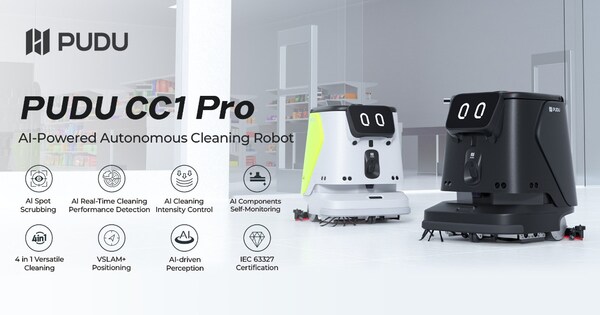Pudu Robotics, the global leader in service robotics, has officially announced the launch of PUDU CC1 Pro, which happens to be an AI-powered autonomous cleaning robot. According to certain reports, the stated robot conceives its …
Pudu Robotics, the global leader in service robotics, has officially announced the launch of PUDU CC1 Pro, which happens to be an AI-powered autonomous cleaning robot.
According to certain reports, the stated robot conceives its four-in-one cleaning solution by effectively combining sweeping, scrubbing, vacuuming, and dust-mopping functions. Complementing that would be powerful AI-driven perception and decision-making which, on its part, is integrated into every stage of the cleaning process.
More on that would reveal how PUDU CC1 Pro can detect liquid stains, recognize floor cleanliness and surface types, adjust cleaning intensity, verify cleaning results, as well as monitor the status of its own components. The idea here is to scale up cleaning consistency and effectiveness, while simultaneously enabling staff to focus on supervision and strategic tasks.
PUDU CC1 also boasts significantly expanded effective cleaning range of 5,000 to 8,000 square meters per operation, something which enables it big time to thrive across large commercial venues, including retail centers, hospitals, airports, and industrial warehouses.
Talk about the whole value proposition on a slightly deeper level, we begin from how CC1 Pro can detect the cleaning effect in real-time. This translates to how, as the world’s first commercial cleaning robot equipped with a rear AI camera, CC1 Pro can continuously monitor the cleanliness of floors.
In fact, if any stubborn stain remains, it marks the location on the map and automatically re-cleans the area. Once the task is completed, a heat map visualizes cleaning effectiveness to help facility managers identify stubborn spots for manual attention, and therefore, foster seamless human-robot collaboration.
Next up, we must dig into the robot’s adaptive cleaning strategy. Here, AI-driven adjustments come into play to optimize cleaning power based on dirt levels and floor type. Complementing that would be a deep scrubbing facility, which effectively activates in heavily soiled zones. There is also an extended run-time mode, capable of operating on cleaner areas.
Beyond that, we have a feature to differentiate floor materials and apply appropriate methods, including vacuuming carpets, sweeping hard floors.
All in all, such a smart adaptation mechanism really goes the distance to deliver an optimal balance between cleaning effectiveness and energy efficiency.
Another detail we must expand upon relates to AI-driven spot scrubbing for targeted cleaning. With visual AI power in its armor, CC1 is able to autonomously identify wet or dirty spots and perform targeted scrubbing for high-efficiency cleaning, conceiving up to three times greater productivity with that approach.
Not just that, the technology also generates heat maps of debris distribution to let staff identify frequently soiled areas and optimize cleaning strategies in large-scale environments.
Hold on, we still have a few bits left to unpack, considering we haven’t yet touched upon the solution’s component self-monitoring & pollution prevention capabilities, capabilities that make CC1 the first commercial cleaning robot focused on autonomously monitoring the condition of its cleaning components through high-precision image recognition.
The stated mechanism allows Pudu’s latest brainchild to detect issues like brush or squeegee contamination from poor maintenance that may cause streaks or water residue. After this, CC1 initiates re-cleaning or alerts staff when needed so to ensure consistent cleaning results and prevent secondary pollution.
We also haven’t touched upon the availability of dynamic navigation with Visual SLAM. Thanks to that, the robot is able to seamlessly navigate complex, dynamic spaces without relying on ceiling markers. Furthermore, it adapts in real time to layout changes and avoids static, along with moving obstacles to achieve smooth operation in busy commercial environments.
Rounding up highlights would be the prospect of accessing visualized intelligence for operational transparency. You see, CC1 Pro provides real-time heat maps and operational dashboards that visualize key data regarding debris distribution, persistent stain locations, and robot performance indicators like task completion rates and maintenance frequency.
These tools bestow both end users and service providers with actionable insights, thus optimizing cleaning efficiency and fleet management.
Among other things, we ought to mention how CC1 packs together several key hardware enhancements that improve durability and operational efficiency. For instance, it offers optional self-cleaning roller brushes, a contour-adaptive brush chamber, and high-durability metal mesh filters.




